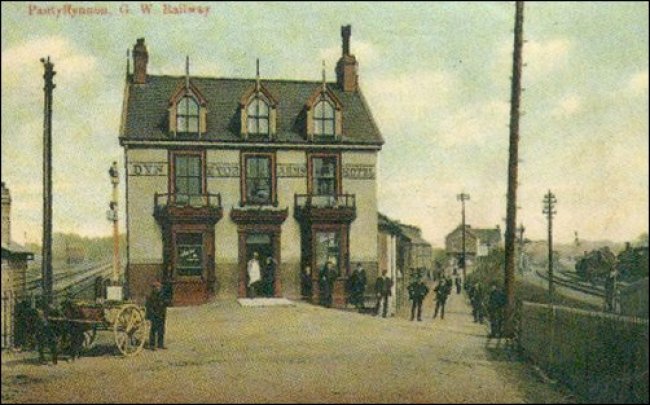
DYNEVOR
ARMS HOTEL
(THE 'TENBY') PANTYFFYNNON
(Scroll
down for history)

The Dynevor Arms Hotel, built in the 1880s, takes its name from the Dynevor Tinplate Works in Pantyffynnon (just left out of the picture). The Tinplate Works had been built in 1880 and in 1943 was the last of the five tinplate works in the Amman Valley to close. The huge building, which once housed rolling mills and other heavy machinery, was demolished in the early 1970s. Another, much smaller, tinplate factory was built on the site bearing the same name of Dynevor Tinplate Works, but only as a tinplate stockist and merchants. The Dynevor Arms Hotel, named after the tinplate works and catering to its legendarily thirsty workforce, became a landmark in Ammanford due to its fine exterior and equally fine interior. It was mentioned in the 1906 edition of Kelly's Directory as the Dynevor Arms Commercial Hotel. Both public house and tinplate works take their name from the local peer of the realm, Lord Dynevor, who once owned all the land around what became Ammanford, with much of the land around Llandeilo belonging to his estate as well. (For a history of the Dynevors from early medieval times to the twentieth century click HERE)
In the right hand background of the photograph can be seen 'Glanhryd Stores', built about 1890. Like so many local shops this was squeezed out of business by the arrival of the supermarkets and was demolished in the 1970s. The railway line at the right is the Llanelli to Brynamman line, built in 1840, and which was the first railway line in Ammanford. This line was closed to passengers in August 1958 though it was used to transport coal from the collieries and open cast sites along the line until the late 1990s.
The railway line at the left is the Swansea to Shrewsbury Heart of Wales line which was extended from Pantyffynnon after 1842 and is still open. In 1904 King Edward the Seventh stopped in his royal train at Pantyffynnon station to enable local dignitaries to make an address to him on his way to Rhayader. A survey by the Welsh ancient monuments organisation (CADW) described Pantyffynnon station as "a remarkable and scarce example of a small scale Brunel design, formally used extensively on the Great Western Railway."
The Dynevor Arms Hotel however has always been known, at least within living memory, by another name – the Tenby – under which name the drinks' license was held for a while. How it became to be called the Tenby is not known for certain but legend has it that in the 1920s a charabanc outing had been organised for the seaside resort of Tenby but which broke down outside the Dynevor Arms Hotel. The rest of the outing was spent inside the welcoming doors of the Dynevor Arms which thus became Tenby, at least for the day. Another version has it that two charabancs had been organised to take the day-trippers, one carrying the women and children which reached Tenby, and the other carrying the men which never left the pub. As the men would have spent the day inside the local Tenby hostelries anyway it wouldn't have made much difference where they were.
Mervyn 'Tenby', the legendary landlord of the Dynevor Arms from 1953 until his reiirement in 1983. Had the local newspaper who took this photograph in 1983 had colour photography, we would be able to see the bright red nose acquired in the pursuit of quality testing his wares. (Photo: South Wales Guardian, 27th Oct 1983). The first proprietor in the 1880s was a Mr John Rees Thomas, but the best remembered landlord was one Mervyn Davies – or Mervyn Tenby, as he was better known – whose bright red nose reassured customers that his wares were being quality tested. Mervyn Tenby lived at the pub as a boy in 1923, when his father became licensee on the acquisition of the house by Buckley's brewery, and he was licensee himself from 1953 to 1983. In the photograph (right), Mervyn is receiving an inscribed salver from Lt. Col. Buckley, Chairman of Buckley's Brewery, to commemorate his long connection with the Brewery. The presentation was made to acknowledge his 30 years tenancy, and also the 60 year family connection.
Mervyn also sported a splendid and luxuriant beard which became his trademark and was ever only once cut for a wager. He was also the owner of the local betting shop as well as several houses in the Pantyffynnon area. After his death in the 1980s the beautiful wood interior of the pub was 'renovated' into a more modern style favoured by the times, though the pub has now been closed down and boarded up for several years. Sic transit gloria mundi.
Date this page last updated: October 1, 2010